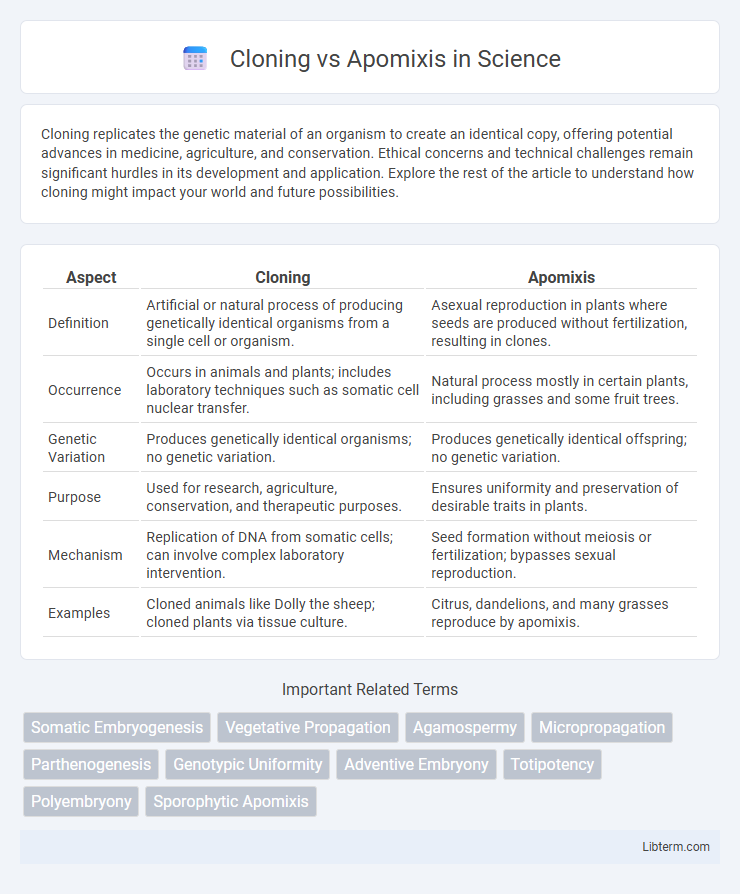Cloning replicates the genetic material of an organism to create an identical copy, offering potential advances in medicine, agriculture, and conservation. Ethical concerns and technical challenges remain significant hurdles in its development and application. Explore the rest of the article to understand how cloning might impact your world and future possibilities.
Table of Comparison
| Aspect | Cloning | Apomixis |
|---|---|---|
| Definition | Artificial or natural process of producing genetically identical organisms from a single cell or organism. | Asexual reproduction in plants where seeds are produced without fertilization, resulting in clones. |
| Occurrence | Occurs in animals and plants; includes laboratory techniques such as somatic cell nuclear transfer. | Natural process mostly in certain plants, including grasses and some fruit trees. |
| Genetic Variation | Produces genetically identical organisms; no genetic variation. | Produces genetically identical offspring; no genetic variation. |
| Purpose | Used for research, agriculture, conservation, and therapeutic purposes. | Ensures uniformity and preservation of desirable traits in plants. |
| Mechanism | Replication of DNA from somatic cells; can involve complex laboratory intervention. | Seed formation without meiosis or fertilization; bypasses sexual reproduction. |
| Examples | Cloned animals like Dolly the sheep; cloned plants via tissue culture. | Citrus, dandelions, and many grasses reproduce by apomixis. |
Introduction to Cloning and Apomixis
Cloning is a biotechnological process that produces genetically identical organisms or cells from a single parent, often through methods like somatic cell nuclear transfer. Apomixis, a natural form of asexual reproduction in plants, enables offspring to develop from unfertilized seeds, bypassing the typical sexual reproduction cycle. Both processes result in progeny with identical genetic material, but cloning is typically artificial and applied across various species, whereas apomixis occurs naturally primarily in certain plant species.
Definitions and Core Concepts
Cloning refers to the process of producing genetically identical organisms or cells through artificial methods, such as somatic cell nuclear transfer, ensuring exact genetic replication of a donor organism. Apomixis is a form of asexual reproduction in plants, where seeds are produced without fertilization, resulting in offspring genetically identical to the parent plant. While cloning emphasizes laboratory techniques to create copies, apomixis occurs naturally and maintains genetic stability across generations in certain plant species.
Historical Background and Development
Cloning and apomixis have distinct historical backgrounds rooted in biological and agricultural research. Cloning's development began in the early 20th century with the experiments of Hans Spemann and progressed to the landmark cloning of Dolly the sheep in 1996, demonstrating the feasibility of somatic cell nuclear transfer. Apomixis, discovered in the late 19th century through botanical studies, has primarily evolved as a natural mechanism of asexual seed formation, with ongoing research aiming to harness its potential for crop improvement and stable hybrid propagation.
Mechanisms of Reproduction: Cloning vs Apomixis
Cloning involves creating genetically identical organisms through artificial techniques like somatic cell nuclear transfer, where the nucleus of a donor cell is implanted into an enucleated egg cell. Apomixis is a natural form of asexual reproduction in plants that bypasses meiosis and fertilization, producing seeds genetically identical to the parent plant. Both mechanisms ensure genetic uniformity, but cloning requires laboratory intervention while apomixis occurs spontaneously within certain plant species.
Genetic Diversity: Comparing Outcomes
Cloning produces genetically identical organisms, resulting in zero genetic diversity as offspring are exact replicas of the parent plant or animal. Apomixis, although also a form of asexual reproduction, can occasionally incorporate low levels of genetic variation through mutations or rare sexual processes, thus maintaining limited genetic diversity within populations. Compared to sexual reproduction, both methods reduce genetic diversity, but apomixis offers a slight advantage in preserving adaptability over pure cloning.
Benefits and Limitations of Cloning
Cloning enables the replication of genetically identical organisms, ensuring uniformity and preservation of desirable traits, which is highly beneficial in agriculture and medicine. However, cloning presents limitations such as reduced genetic diversity, increased vulnerability to diseases, and ethical concerns regarding organism individuality. Despite these challenges, cloning remains a valuable tool for research, species conservation, and therapeutic applications.
Advantages and Drawbacks of Apomixis
Apomixis offers the advantage of producing genetically uniform offspring without the need for fertilization, ensuring the preservation of desirable plant traits across generations and enabling rapid propagation of superior cultivars. However, its major drawback lies in the reduced genetic diversity, which can make populations more susceptible to diseases and environmental changes, limiting adaptability. Unlike cloning, which often requires complex laboratory techniques, apomixis occurs naturally in some plants, providing a cost-effective method for seed production but with less genetic variation.
Applications in Agriculture and Horticulture
Cloning in agriculture enables the propagation of genetically identical plants, ensuring uniformity in crop traits and disease resistance, crucial for commercial fruit trees and ornamental plants. Apomixis offers a method to produce seeds asexually, preserving hybrid vigor and enabling consistent yields in cereals like maize and wheat without the need for repeated hybridization. Both techniques enhance crop quality and productivity, with cloning favored for rapid multiplication of elite genotypes and apomixis providing a sustainable seed production system.
Ethical and Environmental Implications
Cloning involves creating genetically identical organisms through artificial means, raising ethical concerns about biodiversity reduction and potential disruptions to natural ecosystems. Apomixis, a form of asexual reproduction in plants, offers environmental benefits by preserving desirable traits without genetic modification, yet it may limit genetic diversity and adaptability. Both processes demand careful consideration of their long-term impacts on ecological balance and ethical standards in biotechnology use.
Future Perspectives and Innovations
Cloning and apomixis both offer promising advances for agriculture and biotechnology, with cloning enabling precise genetic replication and apomixis facilitating seed production without fertilization. Future innovations may combine cloning techniques with apomictic systems to achieve faster propagation of elite plant varieties while maintaining genetic stability. Advances in CRISPR gene editing and synthetic biology are expected to enhance the efficiency and scalability of both cloning and apomixis, driving sustainable crop improvement and biodiversity conservation.
Cloning Infographic

 libterm.com
libterm.com